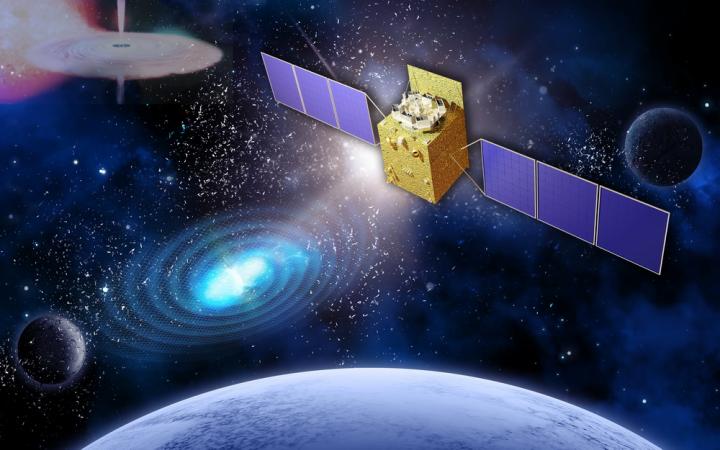
Credit: Image by IHEP
Scientists with the Hard X-ray Modulation Telescope (Insight-HXMT) team presented their new results on black hole and neutron star X-ray binaries during a press conference held Oct. 25 at the first China Space Science Assembly in Xiamen.
X-ray binaries are binary stars that emit X-rays and are composed of a normal star and either a neutron star or black hole. The gravity of the very dense neutron star or black hole causes material from the normal star to fall toward it, creating a rapidly rotating accretion disk that emits intense X-ray radiation. X-ray binaries are an important research target for those trying to understand strong gravitational and magnetic fields and matter affected by them.
The Insight-XHMT scientists were able to study quasi-periodic oscillations (QPOs) in black hole X-ray binaries up to 100 keV, an increase from the previous upper limit of 30 keV. They revealed the energy dependence of QPO amplitude and centroid frequency ranges from 1-100 keV. These achievements exceed what was possible with previous satellites and open a new window for black hole studies.
A detailed timing study of the brightest persistent X-ray source Sco X-1 was also conducted using Insight-HXMT data. The results yielded three key insights: 1) All types of QPOs originate from non-thermal emissions; 2) The innermost region of the accretion disk is non-thermal in nature; and 3) The corona is nonhomogeneous geometrically.
For the first time, scientists observed the sudden change of accretion disk state when the X-ray intensity of a neutron star X-ray binary is at a certain value. This verified the theory, put forward nearly 50 years ago, that the radiation pressure of light causes structural mutation of the accretion disk.
In the past, corona cooling was detected from stacking a series of short Type I bursts that occurred during the low/hard state of a neutron star X-ray binary. The current study represents the first time to observe the rapid cooling of a very hot corona – usually at a high temperature of several hundred million degrees – via a “shower” of low-energy X-ray photons from a single thermonuclear burst on the surface of a neutron star. This method provides a nearly unique means for studying the physical properties and heating mechanism of the high-temperature corona. Also, the interaction between a thermonuclear burst and accretion disk detected in a single burst probably provides a new method for constraining the innermost radius of the accretion disk.
In addition, scientists confirmed that the energy of the X-ray cyclotron absorption line of the famous neutron star X-ray binary Her X-1 is no longer decreasing. The data prove that the magnetic field strength near the X-ray radiation area has become stable after nearly 20 years of slow decline.
Insight-HXMT, as China’s first X-ray astronomy satellite, has observed many black holes, neutron stars and gamma-ray bursts with high precision and cadence since it was launched on June 15, 2017. The satellite comprises three X-ray slat-collimated telescopes – the High-energy X-ray Telescope, the Medium-energy X-ray Telescope, and the Low-energy X-ray Telescope – as well as a space environment monitor.
So far, the satellite has carried out more than a thousand observations and generated 29 TB of scientific data. Altogether, more than 10 scientific papers have been accepted or published in main international astrophysical journals, with additional important research results still in the publication pipeline.
###
Media Contact
GUO Lijun
[email protected]




